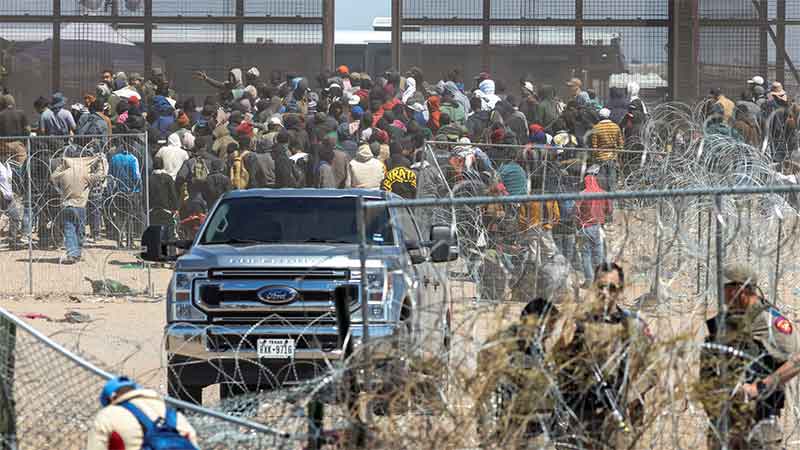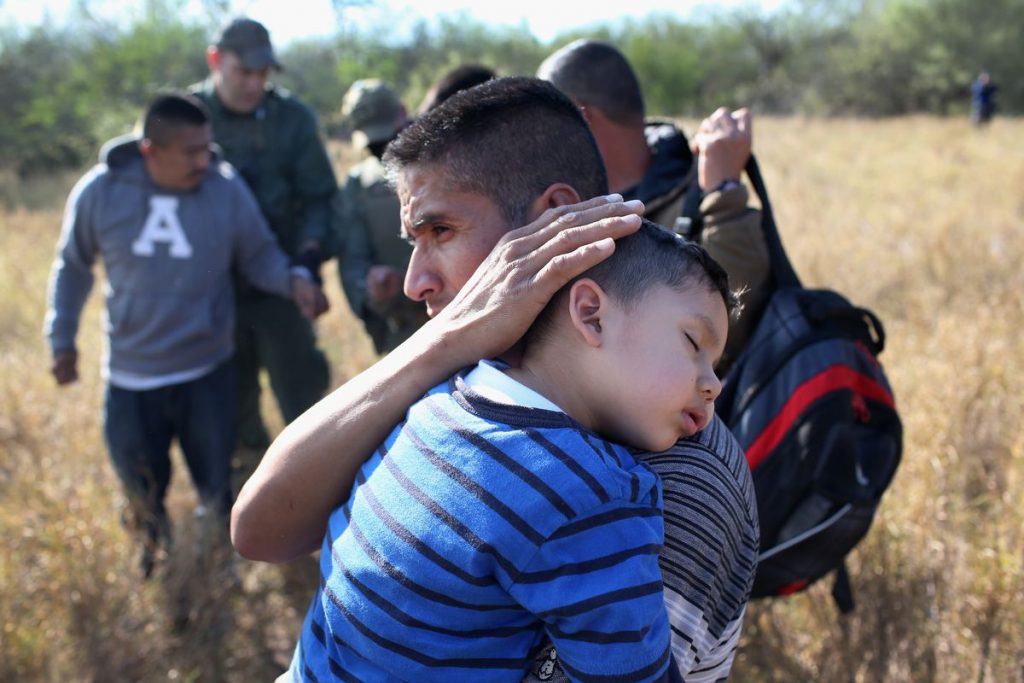
On May 11th, I was with a group of people at the bottom of the Paso del Norte bridge in Ciudad Juárez, Mexico. Suddenly, I realized that I didn’t have the small change needed to cross the bridge and return to El Paso, Texas, where I was attending the 16th annual Border Security Expo. Worse yet, this was just three hours before Title 42, the pandemic-era rapid-expulsion border policy instituted by the Trump administration, was set to expire. The media was already in overdrive on the subject, producing apocalyptic scenarios like one in the New York Post reporting that “hordes” of “illegals” were on their way toward the border.
While I searched for those coins, a woman approached me, dug 35 cents out of a small purse — precisely what it cost! — and handed the change to me. She then did so for the others in our group. When I pulled a 20-peso bill from my wallet to repay her, she kept her fist clenched and wouldn’t accept the money.
Having lived, reported, and traveled in Latin America for more than two decades, such generosity didn’t entirely surprise me, though it did contradict so much of the media-generated hype about what was going on at this historic border moment. Since Joe Biden took office in 2021, the pressure on his administration to rescind Trump’s Title 42 had only grown. Now, it was finally going to happen — and hell was on the horizon.
But at that expo in El Paso that brought together top brass from the Department of Homeland Security (DHS), its border and immigration enforcement agencies, and private industry, I was learning that preparations for such a shift had been underway for years and — don’t be shocked! — the corporations attending planned to profit from it in a big-time fashion.
Seeing the phase-out of Title 42 through the lens of a growing border-industrial complex proved grimly illuminating. Border officials and industry representatives continued to insist that just on the other side of the border was a world of “cartels,” “adversaries,” and “criminals,” including, undoubtedly, this woman forcing change on me. By then, I had heard all too many warnings that, were the United States to let its guard down, however briefly, there would be an infernal “border surge.”
As I later stood in the halls of that expo, however, I became aware of another type of surge not being discussed either there or in the media. And I’m not just thinking about the extra members of the National Guard and other forces the Biden administration and Texas Governor Greg Abbott only recently sent to that very border. What I have in mind is the surge of ever higher budgets and record numbers of Customs and Border Protection (CBP) and U.S. Immigration and Customs Enforcement (ICE) contracts guaranteed to ensure that those borderlands will remain one of the most militarized and surveilled places on planet Earth.
Robo-Dogs at the Expo
Earlier that day, I found myself standing in front of the Ghost Robotics booth. There sat a vendor and, in front of him, a chrome-colored robotic dog on a puke-green carpet. Behind him, a large sign said: “Robots that Feel the World.” He was explaining to prospective customers that the robo-dog could run at a pace of up to nine miles an hour. A vendor in the adjacent booth, Persistent Systems, that claimed to connect “soldiers, sensors, unmanned systems, and cameras in a dynamic network,” was not impressed. (Those, by the way, were but two of nearly 200 companies in that large exhibition hall.). He said, “I’ll take my dog any day,” meaning his living and breathing dog.
The Ghost Robotics vendor responded earnestly, “We are not going to replace dogs!”
All around us, well-dressed corporate types, uniformed Border Patrol agents, and other police officials wandered the aisles, looking at retractable tower masts, taser demonstrations, Glock guns, and facial recognition and iris scanners, part of a border industry that’s been in a state of constant growth for two decades.
Honestly, walking through that exhibition hall was like being in a science-fiction novel that had come to life or perhaps a crystal ball for our border future. The Israel Aerospace Industries banner hovered on the rafters praising a company “Where Courage Meets Technology.” On the ground, the company highlighted its MegaPop high-powered surveillance camera.
The slogan of Tower Solutions, which sells body armor, was more typically down to earth (or do I mean sky-high?): “Speed, Strength, Stability, Elevated.” Armored Republic, which also sells body armor, offered religious fervor in a banner that said: “In a Republic There’s No King but Christ.” But Anduril, the new border darling — 11 contracts with CBP since 2018 — may have caught the enforcement future most perfectly with its “Autonomy for Border Security” banner. Autonomous sentry towers, autonomous drones, and autonomous robotic dogs were to be the true post-Title 42 future, and the exhibition hall was a crystal ball for such a time to come.
Contemplating the Ghost Robotic guy’s response, the Persistent Systems vendor then pointed at the robo-dog and said, “You can weaponize those things and they can go into barracks and blow a motherfucker’s face off.”
The Ghost Robotics vendor responded, “We’re already doing that.” Did he mean weaponizing robo-dogs or blowing a person’s face off? I had no idea.
The Budget Surge
A few hours earlier, DHS Chief Information Officer Eric Hysen assured industry officials that his agency had the “largest budget ever enacted” in its 20-year history. Formerly a Silicon Valley software engineer and program organizer for Google, he had arrived in Washington in 2014 to work in the Obama White House. The next year, he created a Digital Services Team at DHS and “never looked back.” His technocratic language had no Trumpian bluster or hyperbole. It was grounded in numbers and budgets with a bit of social justice spun in (including a mention of a program to hire more women and assurances that, no matter the invasive surveillance technology DHS was developing, privacy issues were taken quite seriously by the department).
At $29.8 billion, the CBP/ICE portion of the DHS budget he praised was not just the highest ever but a $3 billion jump above 2022, including $2.7 billion for “new acquirements in our southwestern border.” In other words, the coming surge at the border was distinctly budgetary.
For context, when Donald Trump took office in 2017 his CBP/ICE budget was $21.2 billion. By 2020, it had gone up to $25.4 billion. In other words, it took him four years to do what the Biden administration essentially did in one. The last time there had been such a jump was from $9.4 billion in 2005 to $12.4 billion in 2007, including funding for huge projects like the Secure Fence Act that built nearly 650 miles of walls and barriers, SBInet which aimed to build a virtual wall at the border (with special thanks to the Boeing Corporation), and the largest hiring surge ever undertaken by the Border Patrol — 8,000 agents in three years.
But if that’s what $3 billion meant in 2005-2007, what does it mean in 2023 and beyond? Gone was the Trump-era bravado about that “big, beautiful wall.” Hysen’s focus was on the Department of Homeland Security’s launching of an Artificial Intelligence Taskforce. A technocrat, Hysen spoke of harnessing “the power of AI to transform the department’s mission,” assuring the industry audience that “I follow technology very closely and I am more excited by the developments of AI this year than I have been about any technology since the first smartphones.”
That robo-dog in front of me caught the state of the border in 2023 and the trends that went with it perfectly. It could, after all, be controlled by an agent up to 33 miles away, according to the vendor, and apparently could even — thank you, AI — make decisions on its own.
The vendor showed me a video of just how such a dog would work if it were armed. It would use AI technology to find human forms. A red box would form around any human it detects on a tablet screen held by an agent. In other words, I asked, can the dog think?
I had in mind the way Bing’s Chatbox, the AI-powered search engine from Microsoft, had so infamously professed its love for New York Times reporter Kevin Roose. A human, using an Xbox-like controller, the vendor told me, will be able to target a specific person among those the dog detects. “But,” he reassured me, “it’s a human who ultimately pulls the trigger.”
The Title 42 Surge
In Mexico, when I walked to a spot where the Rio Grande flowed between the two countries, I ran into a small group of migrants camped out at the side of the road. Near them was a fire filled with charred wood over which a pot was cooking. A pregnant Colombian woman told me they were providing food to other migrants passing by. “Oh,” I asked, “so you sell food?” No, she responded, they gave it away for free. Before they had been camped out for months near the immigration detention center in Ciudad Juárez where a devastating fire in March killed 40 people. Now, they had moved closer to the border. And they were still waiting, still hoping to file applications for asylum themselves.
Behind where they sat, I could see the 20-foot border wall with coiling razor wire on top. There was nothing new about a hyper-militarized border here. After all, the El Paso build-up had begun 30 years ago with Operation Hold the Line in 1993. A desert camo Humvee sat below the wall on the U.S. side and a couple of figures (Border Patrol? National Guard?) stood at the edge of the Rio Grande shouting to a Mexican federal police agent on the other side.
The clock for the supposed Title 42 Armageddon was ticking down as I then crossed the bridge back to El Paso, where more barriers of razor wire had only recently been emplaced. There was also a slew of blue-uniformed CBP agents and several jeeps carrying camouflaged members of border units. Everyone was heavily armed as if about to go into battle.
At the Border Security Expo, Hysen pointed out that fear of a Title 42 surge had resulted in an even more fortified border, hard as that might be to imagine. Fifteen hundred National Guard troops had been added to the 2,500 already there, along with 2,000 extra private security personnel, and more than 1,000 volunteers from other agencies. Basically, he insisted, they had everything more than under control, whatever the media was saying.
At another panel entitled “State of the Border,” Border Patrol Chief Raul Ortiz joked that he would prefer discussing his golf game, only reinforcing that by adding, “As all of America and the political pundits and the reporters run around and say when we lose Title 42 the sky is going to fall, it ain’t gonna fall. We will process people as we normally have during my 32-year career.”
As Department of Homeland Security Secretary Alejandro Mayorkas similarly pointed out, Title 8 authority, the pre-Title 42 enforcement program to which DHS will now return, “carries stiff consequences for irregular migration, including at least a five-year ban on reentry and potential criminal prosecution for repeated attempts to cross unlawfully.” In addition, the Biden administration expects to aggressively expand the process, including implementing a plan to ramp up enforcement far south of the border in the Darién Gap between Colombia and Panama. It’s even possible that U.S. troops will be deployed there for the job. And in a repetitive note at that expo, American officials indicated in a variety of ways that help would, above all, be needed from the corporate world.
Biden Is Already Out-Trumping Trump at the Border
Since the Department of Homeland Security was established 20 years ago, Customs and Border Protection and Immigration and Customs Enforcement have given private companies 113,276 contracts (yes, you read that right!), or on average 5,664 contracts annually, 16 per day. In the 15 years since 2008, the money spent on such contracts has amounted to $72.6 billion dollars and such figures have only been on the rise since Joe Biden entered the White House.
The 4,465 contracts CBP and ICE have agreed to so far this year (at a price of $4.1 billion) put them on pace to surpass 2022’s record-setting $7.5 billion. In 2022, CBP and ICE offered 9,909 contracts, an average of 27 per day, all of which means the Biden administration is likely to be the largest border-enforcement contractor ever.
Only recently, New York Times columnist Thomas Friedman suggested that President Biden should “out-Trump Trump” and “do everything possible to secure the border like never before — more walls, more fences, more barriers, more troops, the 82nd Airborne — whatever it takes. Make Democrats own border security.” What Friedman apparently didn’t realize was that Biden had already taken just that border path.
From his first days in office, the president had stressed technology over wall-building and (not surprisingly) received three times more campaign contributions from top companies in the border industry than Trump did in 2020. And unlike the former president’s Title 42, this policy of contracts, campaign contributions, and lobbying that will push for endlessly higher border budgets is not set to expire. Ever.
At the Edge of Everything — and Nothing At All
On the morning of May 12th, I was with border scholar Gabriella Sanchez at the very spot where the borders of Texas, New Mexico, and Chihuahua meet near El Paso. Title 42 had expired the night before and I asked her what she thought. She responded that she considered this the border norm: we’re regularly told something momentous and possibly terrible is going to happen and then nothing much happens at all.
And she was right, the predicted “surge” of migrants crossing the border actually decreased — and yet, in some sense, everything keeps happening in ways that only seem grimmer. Perhaps 100 yards from where we were standing, in fact, we soon noticed a lone man cross the international boundary and walk into the United States as if he were taking a morning stroll. Thirty seconds later, a truck sped past us kicking up gravel. For a moment, I thought it was just a coincidence, since it wasn’t an official Border Patrol vehicle.
Then, I noted an insignia on its side that included the U.S. and Mexican flags. The truck came to a skidding stop by the man. A rotund figure in a gray uniform jumped out and ran toward him while he raised his hands. Just then, a green-striped Border Patrol van also pulled up. I was surprised — though after that Border Security Expo I shouldn’t have been — when I realized that the initial arrest was being made by someone seemingly from a private security firm. (Remember, Hysen said that an extra 2,000 private security agents had been hired for the “surge.”)
In truth, that scene couldn’t have been more banal. You might have seen it on any May 12th in these years. That banality, by the way, included a sustained violence that’s intrinsically part of the modern border system, as geographer Reece Jones argues in his book Violent Borders: Refugees and the Right to Move. In the days following Title 42’s demise, an eight-year-old Honduran girl died in Border Patrol custody and a Tohono O’odham man was shot and killed by the Border Patrol. In April, 11 remains of dead border crossers were also recovered in Arizona’s Pima County desert alone (where it’s impossible to carry enough water for such a long trek).
In the wake of Donald Trump, everything on the border has officially changed, yet nothing has really changed. Nothing of note is happening, even as everything happens. And as Hysen said at that border expo meeting, big as the record 2023 border budget may be, in 2024 it’s likely to go “even further” into the stratosphere.
Put another way, at the border, we are eternally at the edge of everything — and nothing at all.
Featured image: U.S.-Mexico Border — Nogales, Arizona by Ignatian Solidarity Network is licensed under CC BY-NC 2.0 / Fl.ick















































